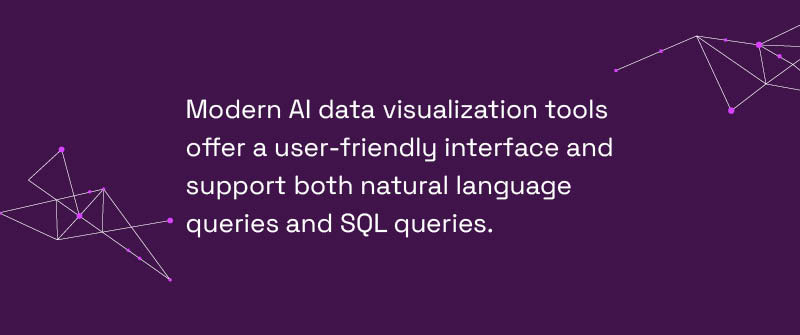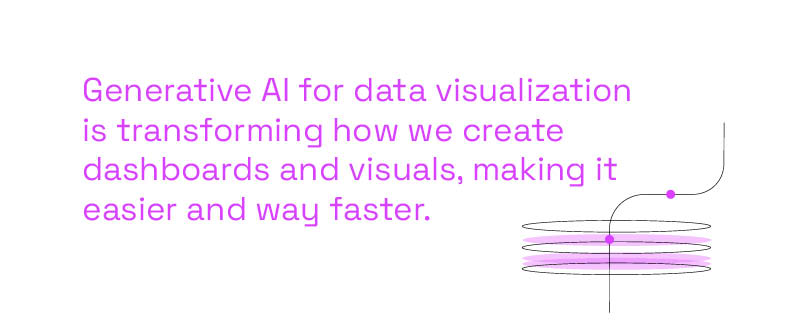
Data is everywhere, and lots of it. But if making sense of your data seems as overwhelming as your inbox on Monday morning, you’re not alone. One study states that only 38% of businesses are extracting value from their data and using it to inform decisions.
For many businesses, AI is quickly becoming the smart choice for analyzing and visualizing data. AI empowers you to spot trends and patterns, tell a story with your data, and make decisions faster. But with so many tools out there, how do you know which one is best for your business? AI data management is also a hot topic. AI data management uses artificial intelligence (AI) and machine learning (ML) to automate and streamline things like data collection, security, and analysis, for example.
We’re here to break down the best AI tools for data analysis and visualization. With the help of an experienced consultant, it may be just what you need to make sense of all the data you’re stockpiling.
What Is The Best AI Tool For Data Analysis And Visualization?
There are a lot of benefits to using AI for data analysis, and many excellent AI data analysis and visualization tool choices out there. AI speeds up the analysis process and makes your data as smart as Sherlock Holmes with a spreadsheet, easily finding hidden patterns that manual analysis can miss.
A consultant can help you set up AI to automate repetitive tasks like data cleaning, transformation, and model building. They can also use AI to create predictive models and generate easy-to-understand visualizations. What’s the best tool out there? A consultant will help you choose what’s best for your needs. Let’s take a look at a few of the top dogs:

Microsoft Power BI: This cloud-based powerhouse is a popular BI tool with awesome AI-powered features for data analysis and visualization, including natural language querying, automated report generation, and interactive dashboards. Plus, Power BI’s close integration with other Microsoft tools, including Fabric and Azure ML, makes it a big winner if you’re already a Microsoft fan. Microsoft Fabric takes analytics to the next level with its AI-powered tools for real-time analytics. Microsoft Fabric is like a springboard to AI, and a Fabric consultant will show you how.
Power BI is great for tracking and reporting corporate success, sales and marketing stats, and financial forecasts. A Power BI consultant helps you tap into the ‘power’ of Power BI.
Tableau: Another popular choice for businesses with AI capabilities that enable advanced analytics and interactive visuals that make it easier to explore and understand data, with features that help with data analysis. Tableau is good for information, business reporting, and real-time tracking of data, but its steep learning curve often puts it a bit out of reach for most mid-market organizations that don’t have the team or skills needed to tackle it.
KNIME: The open-source platform allows users to design, train, and deploy machine learning models with a visual, drag-and-drop interface, making it great for beginners and experienced users. KNIME is great for pharmaceutical research and credit scoring or financial analysis.
Modern AI data visualization tools offer a user-friendly interface and support both natural language queries and SQL queries, enabling business users and data teams to access and analyze large datasets from diverse data sources, including data lakes and Google Sheets, without requiring coding knowledge or technical expertise. These data tools and platforms are designed to enable and empower a broader audience—including data scientists, data scientist teams, and non-technical stakeholders—to efficiently perform complex data analysis tasks and data preparation. Key features and AI features such as embedded analytics, operational efficiency, sensitive data handling, and AI-powered insights are now standard in leading platforms like Zoho Analytics. Artificial intelligence is at the core of these tools, helping with data access, automating data preparation, and supporting advanced analytics for valuable insights. This evolution has led to AI tools that simplify navigation of even the most complex data structures, making analysis more approachable for everyone.
There are more tools out there, including SAS Viya, Databricks, and Google Cloud AI Platform. A good consultant can help you decide which tool makes the most sense. Some things to keep in mind are what type of data you have (think size and complexity), scalability, ease of integration with your existing data sources and systems, and, of course, cost. Also, advanced analytics features like machine learning, predictive analytics, and natural language processing help unlock deeper insights (and keep you ahead of the competition).
A consultant will guide you to ensure the right choice, with an AI tool that aligns with your goals and the type of data you have. They’ll also make sure that security and privacy are a top priority, so you can stress less.
What Is the Best AI for Data Analysis?
We get it, you’ve got legacy systems and siloed data, how in the world can you integrate AI into what you already have? An expert consultant will help with a strategic plan to bring AI into your legacy environment. Here’s what they’ll do:
- Set Clear Goals: What are your goals and objectives for data analysis? Where can AI add the most value? Things like automation, pattern detection, or predictive insights come to mind.
- Assess What You’ve Got: Evaluate existing IT structure, look at data quality, availability, and accessibility (get rid of those data silos) to make sure everything is ready for AI integration. A consultant’s detailed assessment will ensure that what you have works well with modern AI tools.
- Choose Your Tools: A consultant helps choose AI tools that easily integrate with your current systems. Tools that have APIs, custom connectors, or middleware solutions help support seamless integration.
- Train Your Team: Provide training so your peeps know how to use new AI tools and to interpret insights generated. Encourage a culture of innovation and collaboration between stakeholders and teams. And be sure to ease any concerns about AI taking over people’s jobs. P3 Adaptive training is expert-led, and we work with you to build custom team training sessions that fill your specific knowledge gaps.
- Keep Checking on Things: A consultant will show you how to monitor performance regularly and how to make improvements as you go.
With careful planning and expert guidance, you can seamlessly connect AI to your legacy systems, ensuring that data flows smoothly and insights are pulled from your data in real-time. Data analysis happens smarter and faster—so do your decisions. In fact, effective AI integration often starts by working with a skilled data analyst who can identify opportunities for impactful improvements.
Remember when business decisions were often made based on gut instincts? Not the best idea. AI changes that. Data analysis AI enables organizations to generate insights, uncover insights, and make data driven decisions by analyzing data and identifying trends within large datasets. AI-powered analytics also supports data discovery and helps organizations anticipate future trends, leading to more valuable insights. AI can analyze massive amounts of data and find real-time, data-based insights. Things like AI-powered predictive analytics empower you to keep an eye on customer behavior and market shifts as they happen (so you can pivot quickly) or to forecast trends ahead of your competitors. In short, AI provides deeper insights, enabling decision-makers to make informed and strategic choices way faster and to see patterns and trends that help them forecast for the future. By leveraging historical data, AI tools provide even greater context for understanding patterns over time and informing future strategies.

How Is AI Used in Data Visualization?
Generative AI for data visualization is transforming how we create dashboards and visuals, making it easier and way faster. The visualization process is now automated and AI-driven, enabling non technical users to create visualizations and interactive data visualizations directly from raw data. And folks are surely jumping on board the GenAI train. In fact, the global generative AI market is worth $44.89 billion (up from $29 billion in 2022), and in 2024, 92% of Fortune 500 firms adopted generative AI tools.
If you’re looking for faster, more effective ways to analyze data, generative AI data visualization can truly change how you see and use data. How? First, it automates the time-consuming data analysis stuff, taking care of the heavy lifting—meaning faster insights, the ability to make predictions for the future, and speedier decision-making. AI visualization tools use natural language processing (NLP) and human language to help users visualize data and generate visual representations, including network diagrams and interactive visualizations. It simplifies complex information into dynamic, interactive visuals and dashboards that reveal patterns and trends in minutes. Plus data is more accessible (even to non-techy folks) with visuals that clearly tell your data’s story in a dynamic and easy-to-understand way. This shift also enables users to dive deeper into data with less technical friction, encouraging broader participation across teams.
Even better? AI data visualization tools have the power to do text-to-data visualization, taking all the unstructured text data you pull in every day (like customer feedback and reviews, social media conversations, surveys, and internal docs) and converting it to easily see patterns and trends. Text analytics can process natural language at scale. No more reading through mountains of documents. Tools now exist that can process vast volumes of unstructured data to find meaning and create insights in seconds.
Partnering with an experienced consultant is the way to go here. Here’s what they’ll do:
- Prep your data – A consultant knows how to tap into AI’s magic by gathering, cleaning, and organizing your raw data through data preparation, so it’s ready for analysis and visualization.
- Train AI – AI models must be trained using a neural network, large language models, or machine learning to analyze and translate data into visuals using prompts and algorithms.
- Generate smart visuals – Once trained by an expert, AI can generate visuals based on user prompts. AI visualization creates impactful visuals, data stories, and provides AI powered insights such as anomaly detection and actionable insights that automate deep analysis and give you insights you might miss with traditional tools.
- Deliver real-time insights – A consultant will build dynamic, interactive dashboards that update in real-time as data changes.
Lastly, GenAI keeps getting more advanced, but it’s not perfect. Bias, hallucinations, and misleading outputs can happen. A consultant will help you choose tools that have human-in-the-loop feedback features, so you can refine results and ensure accuracy and trust for decision-making. Our team will help you to adopt AI with our custom AI solutions that empower you to use AI effectively and responsibly.
Putting It All Together: AI Tools + The Right Guidance
Using AI tools for data analysis and visualization turns your overwhelming mountains of data into clear insights, faster than you can finish that first cup of coffee. From automating repetitive tasks to generating visuals that enhance data storytelling, AI helps your teams and stakeholders make better decisions (without getting lost in spreadsheets).
Work with us and we’ll collaborate with you to identify high-impact AI use cases that add the most value (and achieve faster ROI). Maybe that’s using AI to create visuals that update sales trends in real time, make predictions that help with supply chain challenges, or use AI data visualizations that track patient outcomes. Automation makes operations more efficient and relieves a lot of headaches.
No matter what you want to achieve with AI, we’ve got you covered. Our team of experts will help you leverage AI to take your business to the next level, and more importantly, to gain a competitive advantage. I mean, that’s the goal, right? We’re here to help you reach those goals with our expert team and the power of AI.
Get in touch with a P3 team member